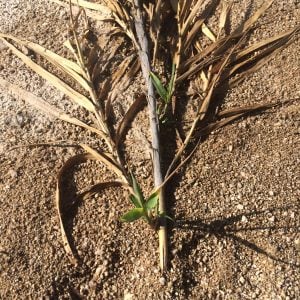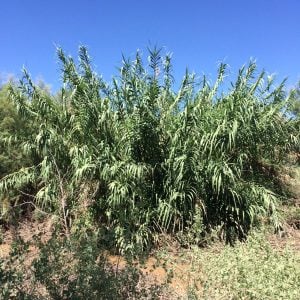
Arundo was introduced in the U.S. from Southeast Asia. Some people now use it around their homes as an ornamental plant. (Photo by Willie Sommers/Arizona Department of Forestry and Fire Management)

Arundo should be pulled out by its roots and disposed of properly, away from water, so it cannot reroot. If it is too strong and thick to pull, a “cut-stump treatment” can help control its growth and spread. (Photo by Willie Sommers/Arizona Department of Forestry and Fire Management)

The giant reed can grow as tall as 30-40 feet. It grows close together, crowding out native plants, and slows river flows. (Photo by Willie Sommers/Arizona Department of Forestry and Fire Management)
PHOENIX – A giant reed that can grow 4 inches per day is choking Arizona rivers, creeks and lakes.
The stubborn Arundo donax plant, an invasive species brought to the U.S. from Southeast Asia, is wreaking havoc in about 30 mostly warm-weather states in the South and West, including Arizona.
According to the University of California, Riverside Center for Invasive Species Research, Arundo was first planted in California in the 1820s to provide roofing and erosion control in the Los Angeles area.
Willie Sommers, invasive plant program coordinator for the Arizona Department of Forestry and Fire Management, says nonnative plants can be described as out-of-control “biological wildfires.” His program provides grants to groups working to remove destructive plants, including Arundo, and is responsible for prioritizing invasive plant treatment.
In particular, Arundo uses a lot of water, makes fires burn hotter, crowds out native species and increases the threat of flooding, he said.

This plant wasn’t disposed of properly and started putting down roots again. These bamboo-like plants, while they can be pretty in your home, can be hard to get rid of once they take hold in the ground. (Photo by Willie Sommers/Arizona Department of Forestry and Fire Management)
Not only is it bad for the water supply but it “can easily spread wildfires because it can carry and burn hotter than our Arizona plants,” Sommers said.
When Arundo grows, it creates a root base around native plants, causing an uplift by raising plants and disrupting the natural floodplain, said Lauren Monheim, program manager for Watershed Management Group’s River Run Network. “It also changes how a river flows because it creates a thick wall, making the water squeeze through a smaller gap.”
The best way to get rid of a giant reed plant is to dig it out by its roots or do a “cut-stump treatment” where the plant is cut near the base and sprayed with herbicide if the roots are too thick to dig up, Sommers said. But the plant, which resembles bamboo, can be aggressive when replanting itself, especially if not disposed of properly.
“You have to be very diligent about removing all of it and taking that material out of the river system or away from the water and disposing of it in some way,” Sommers said.
If not properly disposed of, Arundo will replant and start new roots, especially if it is left flowing down the river, he said. The water will help it regrow fast and start new growth in another part of the river.
One of the department’s grants is helping to remove Arundo in the Tanque Verde Creek in east Tucson.
Watershed Management Group has a program called the River Run Network that removes Arundo around creeks and rivers.
It received a grant in 2021 and has removed about 100,000 pounds, or 50 tons, of Arundo canes since, with 290 volunteers helping out, Monheim said. The group was recently granted funds for another three years to continue its efforts, which help restore groundwater levels and surface flow in the Tanque Verde Creek.
“In a lot of ways, some of this Arundo is people’s personal plant, it’s on their private properties,” Monheim said. “We would not recommend removing it if you see it around your neighborhood, but you can definitely talk to your neighbors and educate them on why it’s so bad.”

The giant reed grows along riverbeds and creeks and can compete with other native plants, growing over them and taking all of their water. (Photo by Willie Sommers/Arizona Department of Forestry and Fire Management)
Watershed Management holds volunteer sessions every Saturday morning through May to remove the giant reed along the Tanque Verde Creek. After volunteers collect the Arundo in giant trash bins, the canes are donated to places to use for fencing and even to feed someone’s lucky goats.
Volunteers can view upcoming events on the group’s website. Later this year, the group will begin replanting native riparian trees and shrubs in areas where Arundo has been cleared.
Friends of the Verde River near Cornville also have benefited from Department of Forestry grants.
Tracy Stephens, program director for Friends of the Verde River, said their removal work attempts to decrease the risk of fire. Once the plants are removed, they are put through a wood chipper and the chips are used to cover trails or parking areas.
Additionally, Friends of the Verde River has received two grants from Forever Our Rivers to help remove Arundo along Oak Creek, which flows into the Verde River from the east. The Arundo Free Oak Creek project removes Arundo as well as other invasive species, including tamarisk, Russian olive and tree of heaven.
“Arundo is just one of many invasive plants, but it’s certainly a giant grass that, once you see it and get to know it, you’ll see it around the state,” said Sommers. “It’s a challenging one, but fortunately we have organizations and agencies out there keeping an eye on it and doing their best to control it.”
